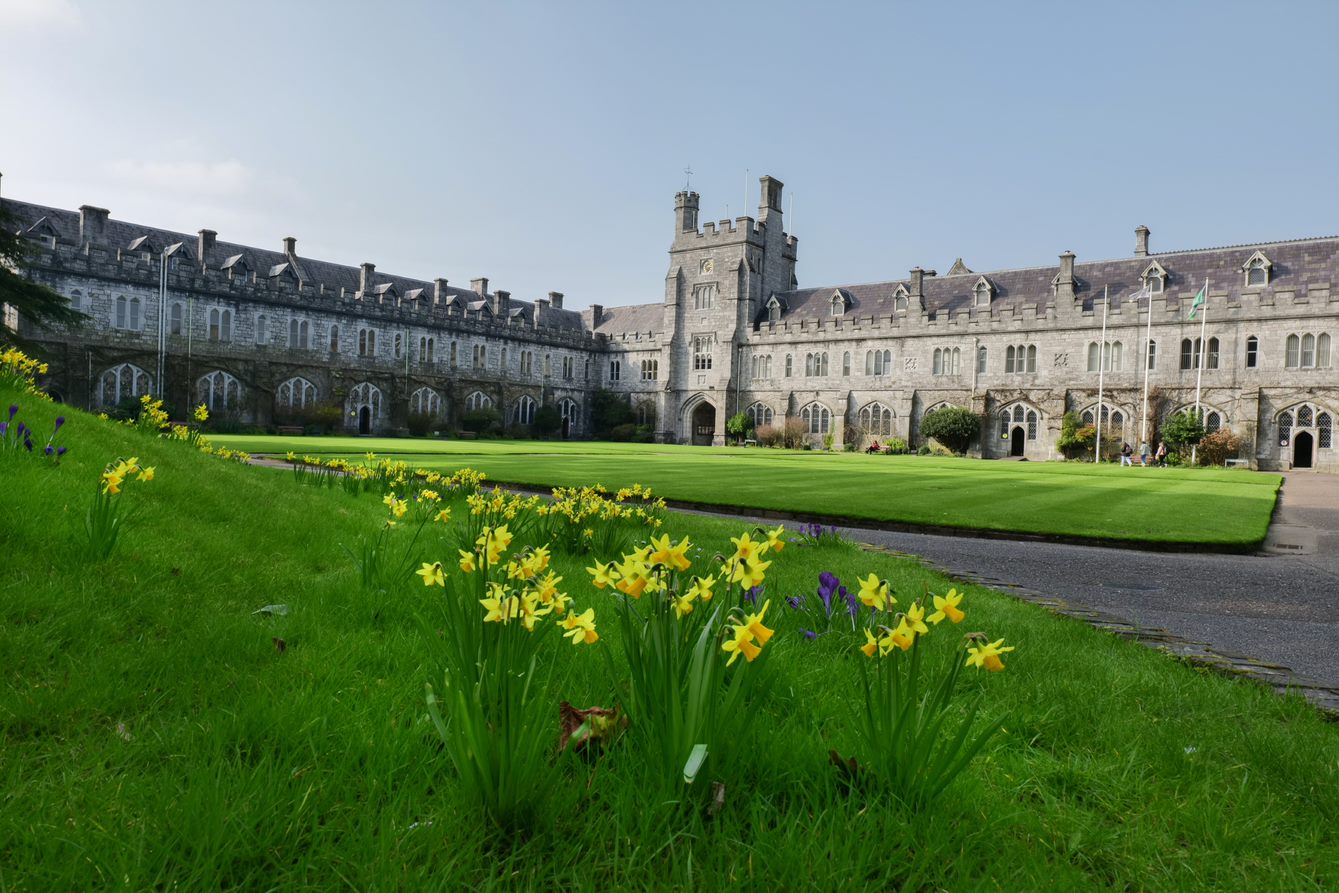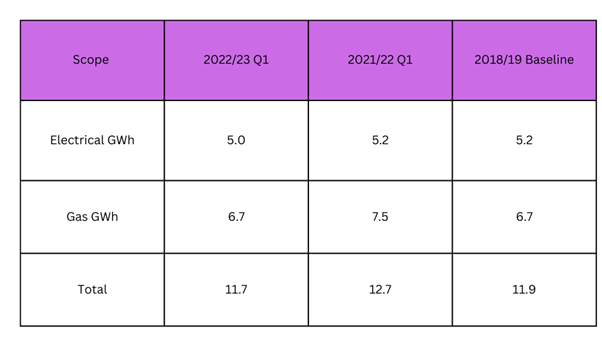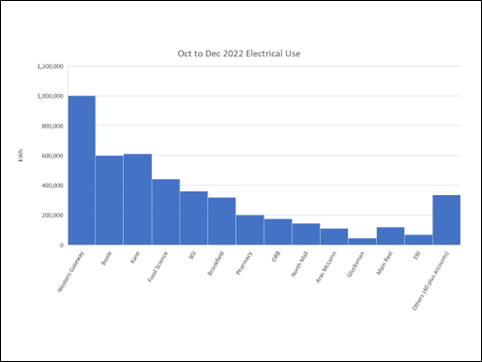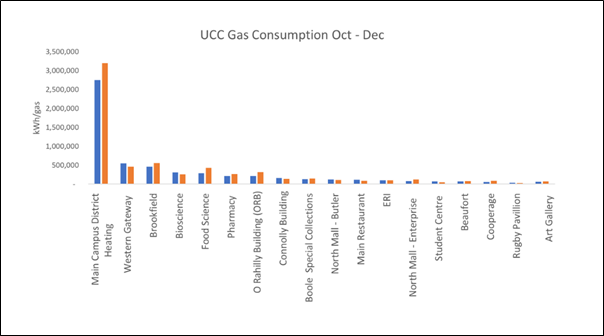- Home
- About
- Student Led
- Research Informed
- Practice Focused
- Resources
- News
- Green Campus Podcasts
- Case Studies
- Green Labs Community
News
October to December 2022 Energy Update

With the first academic term of 2022/23 just gone and with all the energy bills for the October to December period now in we are delighted to report that our overall electrical consumption reduced by 230,000 kWh while our gas consumption came in just below the forecasted levels, mainly due to the milder temperatures over the October and November period.


Electrical Performance Summary
Top 5 Electrical Consumers.
Western Gateway – Our single largest electrical user came in at 999,867 kWh, up 60,000 kWh from the same period in 2021. Electrical use is heavily influenced by external conditions and the term timetable. As one of the most energy-efficient buildings the team at room bookings has moved a lot of evening and weekend events to the building over the last two years and this has caused an increase in its energy use.
Kane Building – The building’s energy use has increased significantly when compared to the 2018/19 period. With the addition of the new ULV lab, the buildings energy load increased by 61,000 kWh for the period. The new LED lighting installed in the Chemistry corridors have offset some of the impacts of the increased activity within the building.
Boole Library reported a decrease of 51,000 kWh on its electrical consumption compared to 2021. Changes to the ventilation settings along with a change in the Christmas opening times can account for most of the savings made in the building.
Food Science – Electrical use in the buildings is largely driven by the research activities that take place in the area. The building saw a slight decrease on its electrical consumption over the period as ventilation rates returned to normal settings and savings from energy projects completed in the summer of 2022 came through.
BSI – The Biosciences building reported a slight decrease in electrical consumption, which is heavily influenced by the research activities that take place within the building.
Natural Gas Consumption Performance
The consumption of natural gas, which is used to heat our buildings, returned to pre-pandemic levels as the ventilation protocols were adjusted. The savings made due to the milder weather over October and November were swallowed up over the month of December as bitterly cold temperatures hit. (Check out our recent post on heating our buildings here to read how we manage and operate the heating systems.)

Top 5 Gas Consumers
Main Campus Gas – By far our largest gas consumer across the Estate, the gas consumed by the district heating network on campus is used to heat the Kane, Electrical Eng, Civil Eng, Main Rest, The Quad, and the Boole Library buildings. While the consumption is down on the same period in 2021 the system is operating around 10% above 2018 levels, mainly attributed to the increased opening hours in the Boole and the absence of reheating due to COVID guidelines. The boilers are fired up at around 04.00 to build up steam pressure by 06.00 so we can send heat out to the buildings on the network. Depending on room bookings and events the heating is typically turned off at 18.00 except for the Boole Library.
Western Gateway – Gas use is largely driven by the humidity requirements for specialist lab areas and is heavily influenced by external conditions. Most of the building is heated by the Ground Source Heat Pump which also recovers the waste heat from the data centre located in the building. Consumption increased slightly due to increased activity and events within the building.
Brookfield Building – Gas is used to provide heating and hot water to the building. With the milder weather and close management, the gas use for the period came in slightly below the same period in 2021.
Bioscience - Two separate heating systems provide heat to the BSI building and following feedback from building occupants, the running times of the heating systems were extended to provide a more comfortable internal environment, resulting in a slight increase on the 2021 consumption levels.
Food Science Building – New boilers were installed in Block A to replace the failing boiler and provide better reliability to the system. As part of the project, the system has been modified to cater for the addition of an air source heat pump in the coming years. A new control system was also installed that will provide better control to reduce energy waste while also delivering a more comfortable environment for the occupants.
Energy Projects Update
The recently installed Heat Pump in the ORB building continued to be optimised over the last few months and we expect the energy performance and internal conditions within the building to improve over the coming weeks and months. As well as the installation of a heat pump the project also carried out repairs to over 400 windows and installed new insulated roof panels and air vents on the top floors. You can access the energy performance of the unit by clicking here
The team of electricians from the Estates office commenced a replacement program for the external lighting, replacing the old lamp fittings with new LED fittings. The new LED lamps were specifically selected to reduce light pollution and minimise the impact on the wildlife and insects around our campus while still providing sufficient lighting levels for security and safety. We hope to bring you an update on this in the coming weeks.
Lastly, No 6 Carrigside underwent a refurbishment over the last few months and building works were completed at the end of the term. The project has been used to test several heating and ventilation strategies that if proven successful, can be rolled out to other similar buildings over time. You can find out more about the project here
To read the full Q1 Energy Performace Update click 2022_23 Q1 Energy Performance Update
If you have any comments, observations or energy-saving suggestions please get in contact with Pat at p.mehigan@ucc.ie
